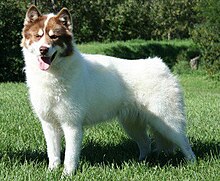Canadian Eskimo dog
 |
|||||||||||||||||||||||||
| Other names |
|
||||||||||||||||||||||||
|---|---|---|---|---|---|---|---|---|---|---|---|---|---|---|---|---|---|---|---|---|---|---|---|---|---|
| Origin | Canada | ||||||||||||||||||||||||
|
|||||||||||||||||||||||||
|
|||||||||||||||||||||||||
| Notes | The UKC does not have an official breed standard Territorial animal of Nunavut |
||||||||||||||||||||||||
| Domestic dog (Canis lupus familiaris) | |||||||||||||||||||||||||
| Traits | |||
|---|---|---|---|
| Weight | Male | 30–40 kg (66–88 lb) | |
| Female | 18–30 kg (40–66 lb) | ||
| Height | Male | 58–70 cm (23–28 in) | |
| Female | 50–60 cm (20–24 in) | ||
| Coat | thick and dense, soft undercoat, stiff guard hairs, mane of thicker fur around the neck | ||
| Colour | about any colour, with or without special markings | ||
| Classification / standards | |||
|---|---|---|---|
| ANKC | Group 6 - Utility | standard | |
| CKC | Working Dogs | standard | |
| KC (UK) | Working | standard | |
| NZKC | Utility | standard | |
| UKC | Northern Breed | standard | |
The Canadian Eskimo Dog is an Arctic breed of working dog, which is often considered to be one of North America's oldest and rarest remaining purebred indigenous domestic canines. Other names include qimmiq or qimmit (Inuit language word for "dog"). They were brought from Siberia to North America by the Thule people 1,000 years ago, along with the Greenland Dog that is genetically identical.
The breed is currently threatened with extinction, with a 2008 estimate of only 300 purebred dogs. Although once used as the preferred method of transportation by Inuit in the Canadian Arctic, by the 1960s traditional working dog teams became increasingly rare in the North. Contributing factors to the breed's decline include the increasing popularity of snowmobiles for transportation and the spread of infectious canine diseases. Controversy surrounds the intentional destruction of a debated number of Inuit sled dogs between 1950 and 1970 by The Royal Canadian Mounted Police as well as recent efforts to increase the breed's population.
The first dogs arrived in the Americas 12,000 years ago. However, people and their dogs did not settle in the Arctic until the arrival of two groups from Siberia, the Paleo-Eskimo people 4,500 years ago and the Thule people 1,000 years ago. The Inuit dogs from Canada (Canadian Eskimo Dog) and Greenland (Greenland Dog) descended from dogs associated with the Thule people, who relied on them for transportation from Siberia.
In 2015, a study using a number of genetic markers indicated that these were both the same dog and should not be treated as separate breeds, that they maintain an indigenous heritage that predates colonization and the timing of which corresponds with the arrival of the Thule people, and that they were distinct from Siberian Huskies, Alaskan Huskies and Malamutes. The maternal DNA sequences of the Inuit dogs were classified as haplotype A31 that indicates a common female ancestor. This haplotype could not be found in other modern dogs; the nearest match was with a 1,000 year–old dog from Florida.
...
Wikipedia
